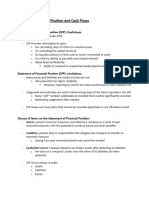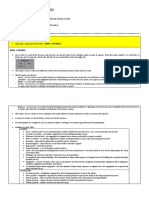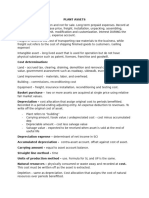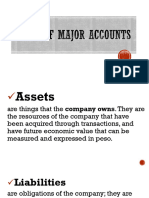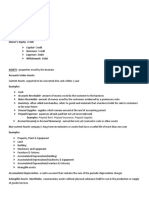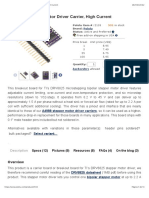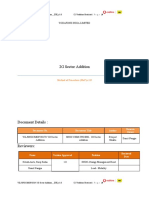Accounting Lecture 2
Accounting Lecture 2
Uploaded by
laylaCopyright:
Available Formats
Accounting Lecture 2
Accounting Lecture 2
Uploaded by
laylaOriginal Title
Copyright
Available Formats
Share this document
Did you find this document useful?
Is this content inappropriate?
Copyright:
Available Formats
Accounting Lecture 2
Accounting Lecture 2
Uploaded by
laylaCopyright:
Available Formats
Accounting lecture 2
Chapter 2: a further look at financial accounting
Current assets
- Assets expected to be converted to cash, sold or used in the business within one year or
one operating cycle, whichever is longer
- Operating cycle is the average time it takes to go from cash to cash in producing
revenue
- Usually listed in order of liquidity
- Reverse order of liquidity also possible
- Examples:
- cash, held-for-trading; short term profit only, investments, accounts receivable;
customer buying things on credit you expect to get money back, inventory: good
held for sale non-current asset, supplies and prepaid expenses: pay for but
haven't used up yet
Non-current assets
- Assets not expected to be converted to cash, sold or used in the business within one
year or one operating cycle
- All assets not considered current
- Examples
- Long-term investments: not held for sale within a year, Property, plant, and
equipment, Intangible assets and goodwill, Other assets
Long-term investments
- Multi-year investments in:
- Debt securities: loans, notes, bonds, mortgages
- Equity securities: shares of other companies
- These assets are normally not intended to be sold (and converted to cash) within one
year
Property, Plant, and Equipment
- Tangible assets with relatively long useful lives
- PPE
- Used in operating the business
- Classify items on how long they will be used for; longest permanency
- Examples:
- Land Buildings, Equipment (eg. furniture, laptop, etc.), Furniture, Computers,
Vehicles
- Usually listed in order of permanency
Depreciation
- allocation of the cost of property, plant, and equipment over their estimated useful lives:
companies systematically assign a portion of the cost of an asset to expense each year
- Under IFRS this allocation is referred to as depreciation for property, plant and
equipment and amortization for intangible assets
- Intangible asset: can’t physically touch it
- Under ASPE amortization is often used instead of depreciation
- The cost of long-lived assets with indefinite lives is not depreciated (e.g. land)
- Accumulated depreciation account shows the total amount of depreciation taken to
date
- The difference between the cost of the asset and its accumulated depreciation is
referred to as the carrying amount of the asset
- Accumulated depreciation is a contra asset account
Intangible asset
- Non-current assets that do not have physical substance and represent a privilege or a
right held by the company
- Examples:
- Patents, copyrights, trademarks, licenses
- Goodwill: excess price paid on acquisition of another company
- Generate a future value to the company
- Amortized if they do not have an indefinite life
Current liabilities
● Obligations that are to be paid or settled within the (longer of the) coming year or one
operating cycle
● Examples:
○ Bank indebtedness, Accounts payable, Unearned revenue, Bank loan/notes
payable, Current maturities of long-term debt
Non-current liabilities
- Debts expected to be paid or settled after one year
- Examples:Bank loan/notes payableLease obligations
- Pension and benefit obligations
- Deferred income tax liabilities
- Usually accompanied by extensive notes to the financial statements
You might also like
- Understanding Financial Statements (Review and Analysis of Straub's Book)From EverandUnderstanding Financial Statements (Review and Analysis of Straub's Book)Rating: 5 out of 5 stars5/5 (5)
- NI - 43 - 101 - Solwara - Deep Sea Mining PDFDocument227 pagesNI - 43 - 101 - Solwara - Deep Sea Mining PDFCarlos A. Espinoza MNo ratings yet
- Statement of Financial Position - PPT - Accounts TitlesDocument23 pagesStatement of Financial Position - PPT - Accounts TitlesMg GarciaNo ratings yet
- Current and Noncurrent AssetsDocument19 pagesCurrent and Noncurrent AssetsMylene SalvadorNo ratings yet
- Chapter 3Document12 pagesChapter 3spambryan888No ratings yet
- Accounting Notes Chap 8-11Document20 pagesAccounting Notes Chap 8-11eemaanzhNo ratings yet
- NeracaDocument7 pagesNeracamadoNo ratings yet
- TEMA 3 Financial AnalysisDocument2 pagesTEMA 3 Financial Analysissofitaf25No ratings yet
- Key Accounting TermsDocument3 pagesKey Accounting TermsLaura TaiNo ratings yet
- Types of Major AccountsDocument25 pagesTypes of Major AccountsRain Sofia LoquinteNo ratings yet
- Chapter 5 - Financial Position and Cash FlowsDocument8 pagesChapter 5 - Financial Position and Cash FlowsCait PostNo ratings yet
- Basic Accounting Module Final TermDocument9 pagesBasic Accounting Module Final TermCharizmae MadridNo ratings yet
- Account TitlesDocument9 pagesAccount TitlesMichael LagundayNo ratings yet
- Financial Accounting ppt02Document31 pagesFinancial Accounting ppt02Bikanair BikanairNo ratings yet
- Accounting Equation and Double Entry SystemDocument52 pagesAccounting Equation and Double Entry SystemArmandoNo ratings yet
- Which Are Converted Into Cash Through Collection: Is Invested in Raw Materials Through Cash Purchase/on AccountDocument3 pagesWhich Are Converted Into Cash Through Collection: Is Invested in Raw Materials Through Cash Purchase/on AccountRuby JaneNo ratings yet
- CMA Notes Unit 1Document29 pagesCMA Notes Unit 1mesharysjNo ratings yet
- Elements of Financial StatementsDocument3 pagesElements of Financial StatementsMargNo ratings yet
- Types of Major Accounts & Chart of AccountsDocument7 pagesTypes of Major Accounts & Chart of AccountsMary Gold Mosquera EsparteroNo ratings yet
- Bookkeeping NCIIIDocument19 pagesBookkeeping NCIIIjanethburac690No ratings yet
- FABM2 Lesson 2Document36 pagesFABM2 Lesson 2Shien ShenNo ratings yet
- Plant AssetsDocument4 pagesPlant AssetsjhunelynecNo ratings yet
- I. Elements of A Balance SheetDocument2 pagesI. Elements of A Balance SheetApril MangarinNo ratings yet
- Reading Material OFFIcers IIDocument103 pagesReading Material OFFIcers IIbaba2303No ratings yet
- Balance Sheet SolutionDocument18 pagesBalance Sheet SolutionRabia RabiaNo ratings yet
- General Guidelines For Spreading Financial StatementsDocument8 pagesGeneral Guidelines For Spreading Financial StatementsChandan Kumar ShawNo ratings yet
- Hba Lap1 - SFPDocument42 pagesHba Lap1 - SFPChristian Dave EvangelistaNo ratings yet
- 9 - The AccountsDocument9 pages9 - The Accountsc.wabingga.723No ratings yet
- Statement of Financial PositionDocument82 pagesStatement of Financial PositionEdmon LopezNo ratings yet
- SUBJECT - FUNDAM-WPS OfficeDocument4 pagesSUBJECT - FUNDAM-WPS Officeabdullahpanonggo8No ratings yet
- Types of Major AccountsDocument30 pagesTypes of Major AccountsEstelle GammadNo ratings yet
- (Acccob2) Notes ReviewerDocument11 pages(Acccob2) Notes ReviewermariesieterealesNo ratings yet
- FABM 1 Major AccountsDocument31 pagesFABM 1 Major AccountscatajannicolinNo ratings yet
- Open Cycle Gas TurbineDocument17 pagesOpen Cycle Gas TurbineBALASAB BIRADARNo ratings yet
- Type-of-Major-AccountsDocument5 pagesType-of-Major-Accountsprincessaboga8No ratings yet
- Five Major AccountsDocument25 pagesFive Major AccountsRhona Primne ServañezNo ratings yet
- Types of AssetsDocument19 pagesTypes of AssetsMylene SalvadorNo ratings yet
- Accounting Standard 6Document208 pagesAccounting Standard 6aanu1234No ratings yet
- Glossary of Financial TermsDocument7 pagesGlossary of Financial TermsCalvin Chavez IIINo ratings yet
- Ch.3, Understanding Financial Statements and Cash FlowsDocument13 pagesCh.3, Understanding Financial Statements and Cash Flowsمحمد اسامہ فیاضNo ratings yet
- Inbound 6107515599265836051Document15 pagesInbound 6107515599265836051Jershane MacamNo ratings yet
- Finance Notes For Mcom StudentDocument5 pagesFinance Notes For Mcom StudentAngel RockNo ratings yet
- 1 Asset AccountsDocument3 pages1 Asset Accountsapi-299265916No ratings yet
- FABM1 Quarter 1 Week 4Document41 pagesFABM1 Quarter 1 Week 4Voltaire NoyaNo ratings yet
- Profit and Loss AccountDocument5 pagesProfit and Loss AccountLanston PintoNo ratings yet
- 11 ACCTS theoryNOTESDocument6 pages11 ACCTS theoryNOTESDeveshi TewariNo ratings yet
- Walang Pamagat Na Dokumento 2Document5 pagesWalang Pamagat Na Dokumento 2apriljanegorre29No ratings yet
- Acct 15Document15 pagesAcct 15academicexcellence21No ratings yet
- Financial Statements - The Annual Report ManagemDocument2 pagesFinancial Statements - The Annual Report ManagemBaischenarizah AbdulNo ratings yet
- Assets, Liabilities and The Balance SheetDocument13 pagesAssets, Liabilities and The Balance SheetMARIA-MIRUNA IVĂNESCUNo ratings yet
- Accounts 1Document3 pagesAccounts 1sarojprashant991No ratings yet
- Basic Accounting EquationDocument3 pagesBasic Accounting EquationpasoknanamanNo ratings yet
- Account TitlesDocument4 pagesAccount TitlesChristian VelascoNo ratings yet
- Assets: (The Conceptual Framework For Financial Reporting - IASB 2010)Document9 pagesAssets: (The Conceptual Framework For Financial Reporting - IASB 2010)Maria MaganesNo ratings yet
- Week 1 Day 1Document6 pagesWeek 1 Day 1Jasmine Cruz SalvaniNo ratings yet
- Financial ControlDocument9 pagesFinancial Controlima funtanaresNo ratings yet
- Types of Major AccountsDocument43 pagesTypes of Major AccountsMaeshien Posiquit AboNo ratings yet
- FM 101 Chapter 3Document41 pagesFM 101 Chapter 3maryjoymayo494No ratings yet
- Accounting ReviewerDocument3 pagesAccounting ReviewerTin RobisoNo ratings yet
- Pleural DiseasesDocument66 pagesPleural DiseasesWin ThuNo ratings yet
- Key Science Skills: Research MethodsDocument28 pagesKey Science Skills: Research Methods25jkyvwkrgNo ratings yet
- Pololu - DRV8825 Stepper Motor Driver Carrier, High CurrentDocument13 pagesPololu - DRV8825 Stepper Motor Driver Carrier, High CurrentMarianoNo ratings yet
- SNOC - CM - MOP - 2G Sector Addition - ZTE - v1.0Document11 pagesSNOC - CM - MOP - 2G Sector Addition - ZTE - v1.0aslam_326580186No ratings yet
- Zeid I., "Mastering Cad/Cam", Tata Mcgraw-Hill, New Delhi, 2005Document3 pagesZeid I., "Mastering Cad/Cam", Tata Mcgraw-Hill, New Delhi, 2005dhaimodkaranishNo ratings yet
- Jenglh9 - Las 2 Q4Document2 pagesJenglh9 - Las 2 Q4Abe PonoNo ratings yet
- 96 - Management of Ankylosed Primary Molars With Premolar SuccessorsDocument1 page96 - Management of Ankylosed Primary Molars With Premolar SuccessorsWillan JumboNo ratings yet
- TMP - 17675-The Draping Technique As A Creative Phase in The Fashion Design Methodology-1-1699154708Document6 pagesTMP - 17675-The Draping Technique As A Creative Phase in The Fashion Design Methodology-1-1699154708ememNo ratings yet
- Linux Interview QuestionsDocument4 pagesLinux Interview QuestionsPaaventhan DharmarajanNo ratings yet
- Designing Wearable Sensors For Preventative HealthDocument355 pagesDesigning Wearable Sensors For Preventative HealthjorgejbmNo ratings yet
- Revov Battery Pack Assembly-and-Installation-Guide-2020Document16 pagesRevov Battery Pack Assembly-and-Installation-Guide-2020Albertus ThomasNo ratings yet
- Phase SequenceDocument16 pagesPhase SequenceMahmoud ElmahdyNo ratings yet
- AIR TICKET InvoiceDocument6 pagesAIR TICKET Invoicepooja PoojamercilinNo ratings yet
- E.O. #16 Barangay Gender and Development Focal Point SystemDocument3 pagesE.O. #16 Barangay Gender and Development Focal Point SystemMarj ApolinarNo ratings yet
- MWB Winter 2018 - Group 4 PDFDocument3 pagesMWB Winter 2018 - Group 4 PDFBá PhongNo ratings yet
- About Accuracy and Sizing of Delta PrintersDocument5 pagesAbout Accuracy and Sizing of Delta PrintersThe Purple SensationNo ratings yet
- Set 1-Paper 2 MS IB HL EconomicsDocument16 pagesSet 1-Paper 2 MS IB HL Economicswj458888No ratings yet
- Respiration MCQDocument3 pagesRespiration MCQSabita SinghNo ratings yet
- Biology ReviewerDocument1 pageBiology ReviewerKevin OnaroNo ratings yet
- SOM Chapter 9Document7 pagesSOM Chapter 9Naveen SNo ratings yet
- Gcse Pe Coursework Analysis PerformanceDocument7 pagesGcse Pe Coursework Analysis Performancefzdpofajd100% (1)
- LoveDocument11 pagesLoveRas ZeruNo ratings yet
- Spring Boot ReferenceDocument377 pagesSpring Boot ReferenceEssidik EddoukaliNo ratings yet
- A Survey of Blockchain From The Perspectives of Applications Challenges and OpportunitiesDocument18 pagesA Survey of Blockchain From The Perspectives of Applications Challenges and OpportunitiesHasan Al-AbadiNo ratings yet
- TBIMOTION GeneralProduct 19.09 (EN) PDFDocument340 pagesTBIMOTION GeneralProduct 19.09 (EN) PDFduongNo ratings yet
- Lecture 3Document25 pagesLecture 3natashamagodoroNo ratings yet
- Amit Bhardwaj CVDocument3 pagesAmit Bhardwaj CVAmit BhardwajNo ratings yet
- Leadership and The OneDocument137 pagesLeadership and The Onenattasantu007124No ratings yet
- Samsung gt-p6210 Service Manual PDFDocument70 pagesSamsung gt-p6210 Service Manual PDFApo Mohammed AlHousenyNo ratings yet











